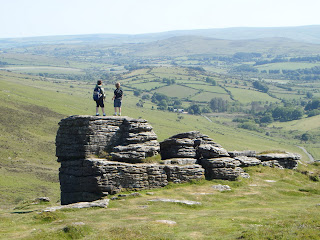Dartmoor National Park has just become my most favorite place on earth. When I think about national parks, the most immediate image is of a forest, such as those I have visited in the U.S.—Rocky Mountains, Acadia, and Yellowstone. Dartmoor, however, was deforested in the 17th century. The trees served as raw material for England’s ship-builidng industry but were never replenished. As a result, Dartmoor’s topography is bare and rugged. Its chief geological feature is a series of over 160 tors, large hills with granite outcroppings.


A quick hike up the steep hill, then a pleasant walk across the hill top, followed by a climb on the rock formation and we were rewarded with incomparable views. The sky was clear and an amazing shade of bright blue, providing a crisp contrast to abundant rocks. Stone walls divide fields, creating a verdant patchwork quilt.



Below the tor, nestled at the base of the next hill (Hameldown) was a large stone circle with smaller stone circles inside. I had read about these circles in a travel guide and knew that it was a Bronze age settlement; the smaller stone circles, called “hut circles,” were houses. Some had very obvious entrances, or front doors, while others showed evidence of fireplaces or hearths. Talk about hitting the motherlode.
At some point, John and Simon headed up Hameldown to see what was on the other side, while Winston and I poked around the hut circles, trying to imagine which house would have been ours had we lived in the Bronze Age. Soon two women, who were out walking their dogs, joined us. We shared some chit-chat. Mostly I wanted to know where we were since the site wasn’t signposted. They didn’t know, which struck me as interesting since they were both locals out for a walk, though one of the women identified the circle as the Grimspound. She told me it was the exact spot where A. C. Doyle had set key scenes in The Hound of the Baskervilles and that I should be reading it at that very moment.
Regardless of missed opportunity, Hookney Tor, which we identified on the huge OS map at Lydford House, and the Grimspound were incredible. I feel luck or good fate had been on our side when we stumbled upon the tor. Later that evening, over a bottle of pinot grigio, John and I plotted our return to Dartmoor. I could be very happy renting a house for a month and walking every tor, plus finding the standing stones and clapper bridges we missed this time around. Until then, I have captured Dartmoor’s beauty on a remarkably sunny day, and I have sources, such as Doyle’s long story and websites to sustain my memory.



No comments:
Post a Comment